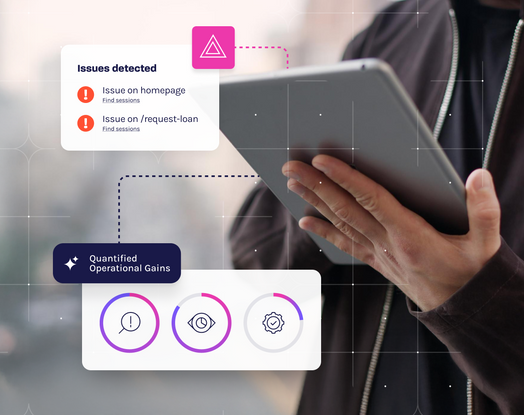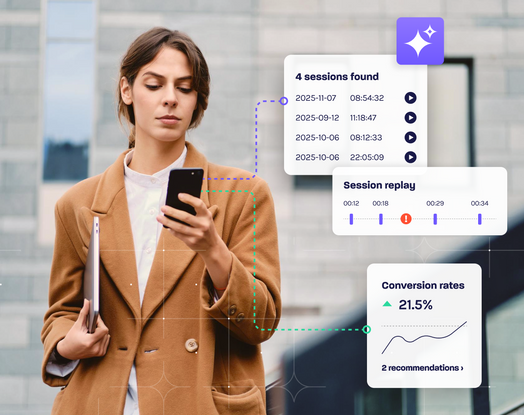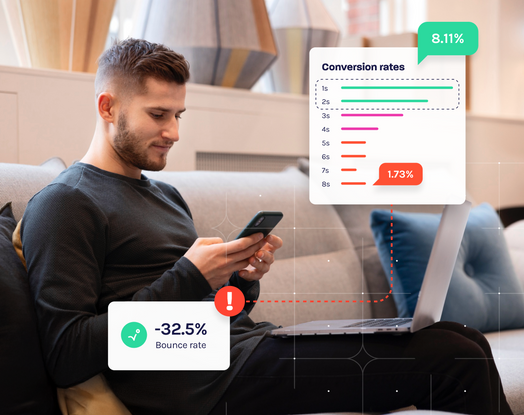
Customer Behavior Analysis: A Full Guide
Understanding customer behavior is essential for driving business growth. It reveals insights into customer actions and motivations, enabling businesses to enhance satisfaction, improve retention and uncover growth opportunities.
Customer behavior analysis systematically decodes these interactions to provide actionable insights. By studying what customers do and why they do it, businesses can identify pain points and optimize experiences that strengthen loyalty and revenue.
At its core, consumer behavior analysis blends data with human motivations to create personalized digital experiences. From tailored dashboards to proactive support, each improvement elevates the overall customer experience while building stronger customer relationships. This guide explores data collection, personalization and strategies for continuous improvement.
This guide will cover everything from data collection to personalization and continuous improvement, helping you effectively leverage insights into your customers’ behavior.
What Is Customer Behavior Analysis?
Customer behavior analysis is the disciplined practice of capturing, unifying and interpreting every digital breadcrumb your customers leave behind. Click paths, session replays, form inputs, support chats and even hesitations on a mobile screen combine to reveal actions, underlying preferences and the motivations that drive them. Unlike a single metric or campaign report, a full analysis layers quantitative data—such as conversion rate shifts and time on page changes—with qualitative clues, including open-text feedback and usability comments. The result is a 360-degree view that helps you pinpoint exactly where value is created, leaked or stalled.
It’s important to distinguish this approach from traditional market research. Market research asks broad questions about segments, trends and potential demand, providing you with a static snapshot of “what” the market looks like. However, customer behavior analysis asks dynamic questions about individual decisions, such as why a high-net-worth client abandons an application at the ID-verification step or why a policyholder repeatedly toggles between deductible options. Because it operates in real time, customer behavior analysis empowers teams to iterate journeys weekly rather than waiting for quarterly survey cycles.
Data alone doesn’t move metrics; action does. Behavior analysis bridges the gap by translating patterns into priorities. If you discover that first-time mortgage applicants struggle with document uploads, you can streamline the interface, add contextual help or trigger a proactive chat. When post-update journey data shows a 12% boost in completion rates, the ROI is clear and defensible. This insight-to-action loop turns analytics from an overhead function into a growth engine.
A crucial component of the discipline is customer journey analytics. By stitching together web and mobile sessions, journey analytics reveals where users land, how they move through multiple channels, bounce between comparison tools and revisit support FAQs before converting. It highlights loops, detours and dead ends, giving product, marketing and compliance teams a shared source of truth for prioritizing fixes and opportunities.
In short, customer behavior analysis transforms raw behavioral data into actionable insights that elevate customer satisfaction, reduce churn and unlock new revenue.
Why Customer Behavior Analysis Matters for Business Outcomes
Organizations that embed customer behavior analytics into their decision-making processes often see measurable results, including double-digit increases in conversion rates, lower acquisition costs and stronger customer lifetime value. By identifying exactly how customers interact with digital journeys, teams can fine-tune experiences that convert more visitors into loyal customers.
But the numbers only tell part of the story. The real advantage comes from understanding why customers struggle. Quantitative data paired with qualitative insights—session replays and open-text feedback—helps uncover the emotional drivers behind friction. Moments of hesitation, repeated field entries or pinch-zooming on poorly formatted content give product teams firsthand empathy for the experience. This human context drives better, more intuitive design decisions.
By highlighting these moments of friction, behavior analysis helps teams reduce obstacles across the entire digital journey. Metrics like rage clicks, navigation loops and abandonment rates reveal exactly where to focus efforts for maximum impact. The result? Smoother pathways to value, higher customer satisfaction and stronger retention rates.
Takes this further with struggle and experience scores to quantify friction at scale. These automated metrics analyze each session for patterns like repetitive actions, errors or confusion loops. With these scores, teams gain instant visibility into which visitors are struggling, why they’re struggling and how those struggles are affecting overall experience and sentiment. This empowers businesses to prioritize quick wins while steadily improving the full customer journey.
Customer behavior analysis is a growth strategy that creates a feedback loop driving continuous improvement. For example, marketing teams can craft a marketing campaign based on actual behaviors not assumptions, product managers can build features that solve real problems and leadership can link customer experience improvements directly to revenue growth. In short, analyzing consumer behavior transforms reactive optimization into a proactive business strategy, with stronger ROI to match.
Essential Data Sources: Using Qualitative and Quantitative Data Together
Balanced insight starts with balanced data. Relying on only numbers or narratives leaves gaps that can skew decisions. Blending quantitative and qualitative inputs produces the context you need to act with confidence.
Quantitative data tells you what happened and how often. Core metrics include:
Click-through rates on promotional banners
Time on page for key product explanations
Funnel conversion rates from application start to submission
These hard figures pinpoint drop-offs, reveal high-performing paths and quantify the scale of any issue.
Qualitative data explains why it happened. Common sources include:
Post-interaction customer surveys that capture emotion in free text
Usability interviews where participants verbalize confusion or delight
Open-ended feedback widgets that surface in-moment comments
Because these customer behavior insights come directly from users, they expose sentiments that a dashboard can’t.
The real power appears when you merge the two. The richest view emerges when qualitative nuance and quantitative rigor share the same canvas.
Tagless data capture records every click, gesture and error without manual instrumentation, then pairs those events with session replay and voice-of-customer inputs. Product teams can watch a single journey, see that an error message flashes four times, read the user’s complaint in real time and calculate the abandonment cost.
Blended analysis also reveals patterns you may not think to investigate. By running path analysis across both data types, you may discover that customers who watch a “how it works” video and then read FAQs tend to convert faster, or that policyholders who encounter a specific validation error are more likely to call support. These correlations surface new hypotheses that drive continuous optimization.
In short, the marriage of quantitative breadth and qualitative depth transforms scattered signals into a coherent narrative. When data collection is comprehensive and effortlessly unified, every stakeholder can make decisions that resonate with real customer needs.
Segmenting Your Customers for Meaningful Insights
Segmentation is the practice of grouping your customer base into distinct cohorts to tailor experiences, offers and communications with precision. When segmentation aligns with the analysis of consumer behavior, it moves beyond static customer demographics to reveal actionable patterns that drive revenue and retention.
You have several lenses for each customer segment, shining light on a different facet of customer needs. Primary categories include:
Demographic
Geographic
Psychographic
Behavioral
Firmographic
Among these, behavioral segmentation is often the most important as it anchors decisions in what customers actually do. By clustering users based on actions, such as frequency of logins, customer preferences or common struggle points, you can launch targeted marketing campaigns, prioritize product enhancements and forecast customer lifetime value with greater accuracy.
Of course, the best-performing segmentation method depends on your use case. A compliance team might use firmographic traits to align disclosures with regulatory jurisdictions, while a mobile product team may prioritize behavioral signals, such as swipe patterns or repeated error encounters. The key is matching the segmentation lens to the business question at hand.
Real-world examples underscore the impact. Consider a financial institution that uses journey analytics to map multiple digital paths and segment customers by journey stage and struggle scores. Simplifying screens for high-value cohorts reduced support calls and helped the company save $1.5 million annually. Another example of success is a major food brand that combined error analysis with journey mapping to isolate mobile users who abandoned carts during checkout. By correcting a specific technical glitch, the brand cut abandonment and lifted conversions within weeks.
When you weave segmentation into ongoing customer behavior analytics, you create a feedback loop that continuously refines marketing strategy, product design and customer service. Each new insight sharpens your understanding of customer behavior patterns, turning data into differentiated experiences that keep loyal customers coming back.
Common Buying Behavior Frameworks and What They Tell You
Every purchase follows a journey, and most journeys move through three fundamental stages: awareness, consideration and decision. Mapping these stages provides a scaffold for your customer behavior analysis, helping you recognize where curiosity turns into intent and, eventually, action.
Over the decades, academics and practitioners have developed frameworks that clarify how buyers move through these phases. Understanding their nuances helps you diagnose friction, personalize touchpoints and forecast future behavior with greater certainty.
Key Customer Behavior Models
Purchase Funnel: This model visualizes the gradual narrowing of prospects from awareness at the top to conversion at the bottom, highlighting leak points where potential customers drop out.
AIDA Model: This model breaks attention, interest, desire and action into distinct mental checkpoints, ensuring messaging and content are matched to cognitive readiness.
Economic Model: This model assumes rational buyers weigh price, utility and constraints, making it useful for pricing strategy and value differentiation.
Learning Model: This model emphasizes how past experiences, reinforcements and cues shape habitual buying behavior, guiding loyalty and retention initiatives.
Psychoanalytical Model: This model focuses on subconscious motives, such as status and emotion, to inform brand positioning and experiential design.
Sociological Model: This model examines the influence of social class, culture and reference groups, helping segment users by community-driven preferences.
Digital ecosystems have added complexity to these frameworks. Always-on mobile access means the path from awareness to decision can compress into a single session or stretch across countless micro-moments. Social proof, real-time reviews and hyper-personalized offers can loop buyers back and forth within stages, creating what analysts call the “messy middle.” To adapt, real-time behavioral signals—scroll depth, dwell time, rage clicks—are overlaid onto classic models, turning static theory into dynamic maps that evolve with each user interaction.
When you layer these frameworks onto your customer behavior data, patterns jump out. An uptick in repeat page views without corresponding conversions may signal buyers oscillating between interest and desire. High struggle scores on mobile during the decision stage might suggest checkout anxiety, prompting a redesign of payment flows or additional reassurance messages.
In heavily regulated sectors like banking, financial services and insurance (BFSI), the stakes of misunderstanding intent are high. Buyers often engage in complex buying behavior, juggling risk, compliance disclosures and substantial financial commitments.
Best practices for BFSI sectors include:
Aligning each framework stage with mandated disclosures so compliance content appears exactly when the buyer needs it.
Using behavioral segmentation to offer tailored calculators or quote simulations during the consideration phase, reducing cognitive load.
Integrating secure, low-friction verification tools at the decision point to prevent abandonment without compromising regulatory standards.
Conducting parallel analysis of struggle and experience scores to spot policy application pain points early.
Following industry-specific guidance to ensure that every optimization respects privacy, security and legal requirements.
By grounding your digital CX in proven frameworks and tuning them for real-time customer data, you transform theory into an operational advantage, helping your teams craft experiences that convert curiosity into loyal customer relationships.
Personalization Powered by Behavior Analysis
When you can see exactly how each visitor explores your digital properties, product and service improvements stop being educated guesses. A sudden surge in taps on a “compare rates” button may signal demand for clearer pricing breakdowns, while repeated zoom gestures on policy fine print can justify reformatting disclosures. Customer behavior analysis turns these observations into a roadmap for enhancements that resonate with real needs.
Personalization means making every customer interaction feel like it was specifically made for the individual based on their behavior, not just their demographic profile. By harnessing data from clicks, scrolls, support chats and previous purchases, you can surface a relevant behavioral analytics tool, suggest next-best actions and time offers precisely when customers are most receptive. The result is a smoother journey that lifts satisfaction scores and drives incremental sales.
Digging into customer engagement patterns reveals where relevance matters most. For instance, users who repeatedly hover over mortgage calculators but never start an application may need upfront eligibility guidance, while long-time policyholders who check coverage details after a weather alert might appreciate contextual claim tips. Aligning content, features and assistance with these behaviors forges stronger relationships and reinforces brand trust.
Artificial intelligence supercharges this process. Machine learning models digest historical sessions, predict the next customer action and trigger real-time adjustments that manual rules simply can’t match. Examples include:
Dynamic website content that rearranges modules based on the visitor’s prior interactions.
Personalized investment recommendations that consider risk appetite inferred from browsing depth.
Targeted promotions that land in mobile apps moments after a user shows intent, such as adding a policy rider or exploring credit-card benefits.
These AI-driven experiences elevate engagement while preserving the speed and security that financial customers expect.
By moving from static personas to behavior-based personalization, you shift from marketing to your audience directly to serving each customer in the moment. That shift translates into higher loyalty, lower customer churn and a competitive edge that’s tough to replicate.
Measuring the Success of Customer Behavior Analysis Initiatives
The value of analyzing customer behavior becomes real only when you can prove its impact. Clear performance indicators help you separate cosmetic tweaks from meaningful optimizations and justify further investment.
Start by focusing on metrics that directly reflect the goals of your behavior-driven initiatives.
Key measures include:
Conversion rate: How effectively journeys turn visits into transactions.
Churn rate: The percentage of customers who leave during a given period.
Average order value: The typical revenue per transaction.
Engagement score: A composite index of clicks, scroll depth and session duration.
Customer lifetime value (CLV): The projected revenue a customer generates over their relationship with your brand.
Each of these metrics leads to tangible business outcomes. A higher conversion rate drives immediate revenue, lower churn preserves future income and an expanding CLV signals that your experience keeps customers invested longer. By tying improvements to financial indicators, you make the case for continued optimization across product, marketing and service teams.
Behavior analysis thrives in a continuous improvement cycle: analyze, adjust, measure, repeat. After implementing a change, track the same metrics you used to identify the problem. If abandonment drops and completion rates climb, you have direct evidence of success. If results stagnate, dive deeper into session replays or open-text feedback to uncover lingering friction.
For granular, session-level insight, frameworks such as struggle and experience scores deliver real-time visibility into customer pain or delight. These scores aggregate signals like rapid back-and-forth navigation, repeated errors and long idle times to quantify frustration. Monitoring them alongside high-level KPIs indicates micro-issues before they balloon into macro-losses.
When you consistently align metrics with behavior insights, you create a feedback loop that not only tracks progress but also uncovers the next wave of opportunities. Over time, this discipline turns measurement from a retrospective report into a forward-looking roadmap for sustained growth.
Ready to Decode Customer Behavior? Glassbox Can Help
Customer behavior analysis equips you to meet customers where they are, fix friction fast and drive measurable results. Doing it well requires unified data, intelligent analytics and cross-team collaboration—capabilities built into Glassbox from the ground up.
Glassbox captures every web and mobile interaction, then layers AI to surface the insights that matter most. Struggle scores spotlight urgent issues, journey maps reveal hidden detours and session replays show exact user experiences. Armed with this clarity, your teams can prioritize enhancements that elevate experiences and boost revenue.
The next step is turning insight into action, and that’s where Glassbox’s product analytics excels. The module links behavior metrics to feature adoption, funnel progression and conversion outcomes, so you can quantify the impact of each release and iterate with confidence. From A/B experimentation to cross-channel performance tracking, every decision becomes data-backed and results-focused.
Ready to see how deep behavior insights translate into stronger business outcomes? Explore Glassbox’s product analytics today and start converting clicks into lasting customer loyalty.







